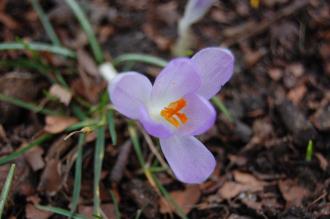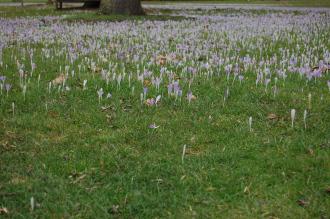
Crocus tommasinianus detail (18/02/2012, Kew, London)
Position: Full sun to dappled shade
Flowering Period: Early spring
Soil: Moist, well drained
Eventual Height: 10cm
Eventual Spread: 5cm
Hardiness: 3a – 9a
Family: Iridaceae
Crocus tommasinianus is a deciduous, dwarf perennial corm with a tufted growth habit. Its dark green leaves are linear with a silvery central stripe and entire leaf margins. The leaves appear at the same time as the flower and remain until early summer when the wither. The flowers of the plant are borne singly, up to 5cm long, goblet in shape with six petals joined at the base of the flower. The petal color ranges from pale purple/ lilac to red/ purple. The stamens are yellow/ orange and generally appear in pairs of 3.
Crocus tommasinianus, commonly known as the Woodland Crocus, Tomasini’s Crocus, Early Crocus and Snow Crocus, it is native to south eastern Europe.
The etymological root of the binomial name Crocus is derived from the Greek name Krokos, a thread, which was actually the filaments of the styles being the source of the dye. Tommasinianus was named after the botanist Muzio G. Spirito de Tommasini (1794-1879).

Crocus tommasinianus (18/02/2012, Kew, London)
The landscape architect may find Crocus tommasinianus useful for naturalising areas of grass, including grass banks. As this corm is tolerant of dappled shade it is suitable naturalizing under deciduous trees.
Ecologically, C. tommasinianus is pollinated by bees and beetles. It is a valuable source of pollen and nectar for insects in late winter.
C. tommasinianus has been awarded the prestigious Royal Horticultural Societies annual Award of Garden Merit in 1993.
C. tommasinianus prefers moist, moderately fertile, well drained soil. It will tolerate most pH of soil. It will not tolerate water-logging.
Maintenance: This plant requires little maintenance. If naturalised in grass, the grass should not be mown until the leaves of the Crocus have died down. Advertisement
